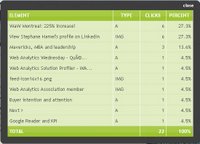Last updated: March 11th, 2008How do you follow the most interesting conversations about Web Analytics? Subscribe to the most complete aggregated feed of blogs discussing about web analytics!
Current conversations
Add to Google Reader or use your own readerAll of those are also included in the Web Analytics Co-Op Search
- Advanced Web Metrics by Brian Clifton
- Always be testing by Andy Edmonds
- Analytical Engine by Diamond Management & Technology Consultants
- Analytics by Adam Berlinger
- AIMS Canada
- Analytical Engine - Diamond Management & Technology Consultants
- Analytics Insider - from the authors of Web Analytics for Dummies
- Analytics Notes by Jacques Warren
- Analytics Talk by Justin Cotroni (EpikOne)
- Andy Beal's Marketing Pilgrim - Internet Marketing Blog & Consultant
- Benry
- BobPage.net - Information overload
- Brad Warthan
- braden's web analytics, usability & online marketing blog
- Business Analytics by Khanal Bhupendra
- Canalytics
- Cliff Allen on Marketing
- Coffee, Sun & Technology
- Commerce360 by Craig Danuloff
- Conversion Rater
- Customer Intent, Michael Stebbins at Market Motive
- Daniel Shields on Web Analytics Demystified
- Data Sciences Analytics by John Aitchison
- Data Mining Research by Sandro Saitta
- Digital Media Analytics
- Digital Alex by Alex Cohen
- E-consultancy - Web Measurement and Analytics - News and Blog
- Foviance
- Freelance Web Analytics by Anil Batra
- GA Experts - Google Analytics & Urchin Software
- Gilligan on Data by Tim Wilson
- Good Behaviour Blog by Hugh Gage
- Google Analytics Blog
- Greater Returns by Aaron Gray
- GrokDotCom - The Converstion Rate Marketing Blog
- immeria - an immersion into Web analytics by S.Hamel
- Influence Analytics from "Wandering" Dave Rhee
- inside analytics
- Inside Web Analytics
- Instant Cognition
- John Lovett from Jupiter Research
- Juan Damia's blog
- Juice Analytics
- June Dershewitz on Web Analytics
- Lies, Damned Lies...
- Lunametrics by Robbin Steif
- Marketing Productivity Blog by Jim Novo
- Mastering Web Analytics, using Google Analytics
- Mymotech by Michael Helding
- The Dashboard Spy - Enterprise Dashboard Screenshots
- The MineThatData Blog by Kevin Hillstrom
- Negligible quantities by Julien Coquet
- Occam's Razor by Avinash Kaushik
- Occam's Razor Comments
- On the Trail
- One Degree
- Orthogonal Thinking by John Marshall at Market Motive
- Pages vues by Benoit Arson
- Passionate Analyst by Dylan Lewis
- Pattern Finder
- PlusOneAnalytics
- Random Analytics
- Rich Page Rambling by Rich Page
- SEMAngel by Gary Angel
- Share The Genie's Power :: ClickInsight Blog
- Signum sine tinnitu--by Guy Kawasaki
- The Big Integration by Jacques Warren
- The Blackbeak Blog.... Arr!
- The Commerce360 Blog
- The Dashboard Spy by Enterprise Dashboard Screenshots
- The Site is Dead - Offermatica
- this just in
- Tracking Techniques
- Turn Up The Silence - iPerceptions Blog
- Unofficial Google Analytics Blog
- Visioactive by Ian S. Houston
- Web Analytics Association Blog
- Web Analytics and Optimization Blog by Mike Sukmanowsky
- Web Analytics: Information for the average user by Matt Lillig
- Web Analytique et Optimisation by Jacques Warren (in French)
- Web Analysts.info by Lars Johansson
- Web Analytics & Affiliate Marketing by Dennis R. Mortensen
- Web Analysis and Online Advertising by Anil Batra
- WebAnalyticsBook
- Web Analytcs: Information for the average user
- Web Analytics Analyzed by Paul Strupp
- Web Analytics Applied Paul Legutko (Semphonic)
- Web Analytics Association
- Web Analytics Guru by Britney
- Web Analytics in China by Florian Pihs
- Web Analytics Management by Phil Kemelor
- Web Analytics Matt by Matt Hopkins
- Web Analytics Princess by Marianina Chaplin
- Web Analytics Pulse by Anil Umachigi
- Web Analytics RSS Feed by Hurol Inan
- Web Analytics Tool Time by Jesse Gross (Semphonic)
- Web Analytics World
- webanalytics at Yahoo! Groups
- Web Optimization Blog by Debbie Pascoe (Maxamine)
- Web Sense by Joel Hadary (Semphonic)
- Web Strategy by Jeremiah
- WebAnalytics.be Blog
- WebMasterFarms
- WebMetricsGuru by Marshall Sponder
- WebSideStory Customer Blog
- Xavier Casanova's Blog Coffee, Sun & Technology








